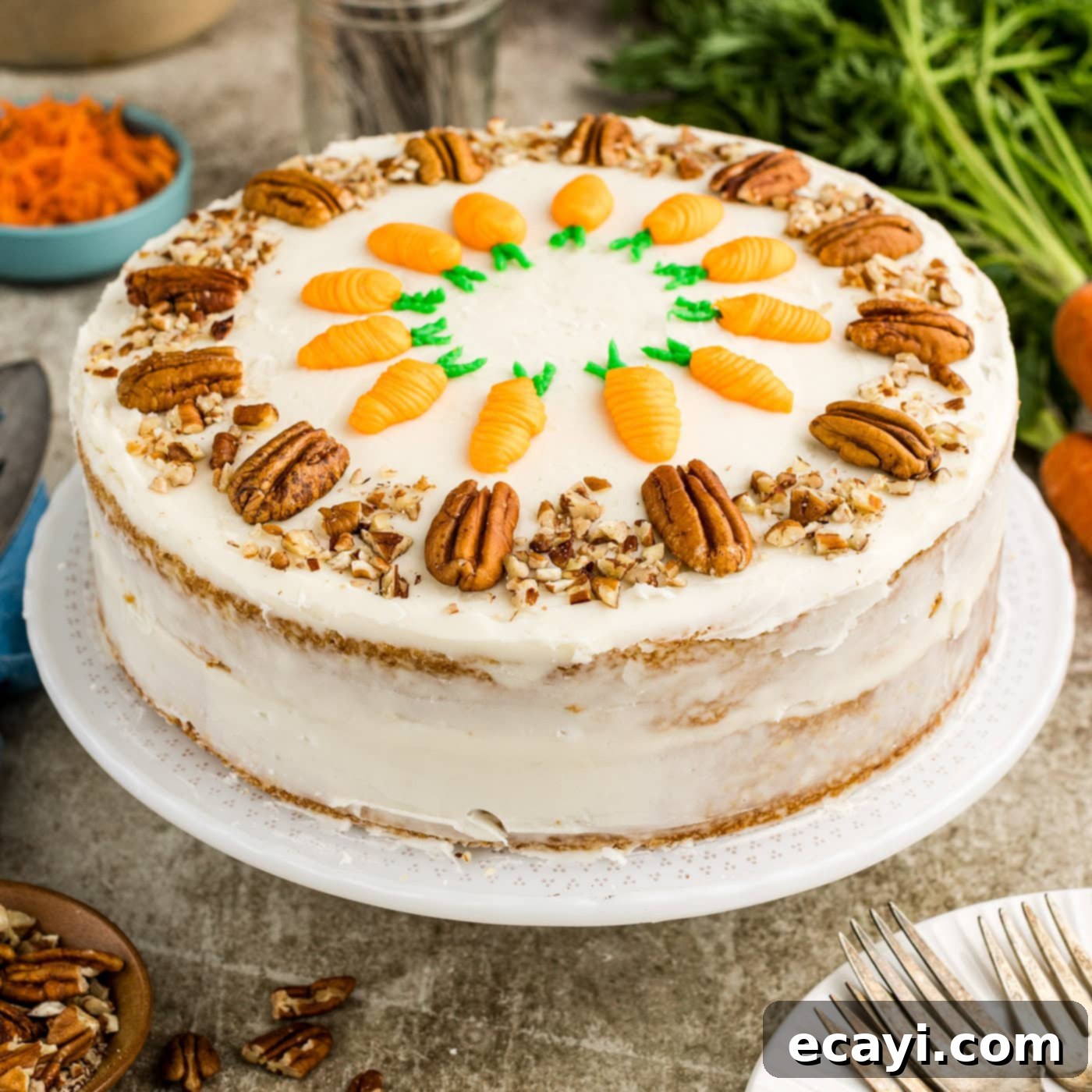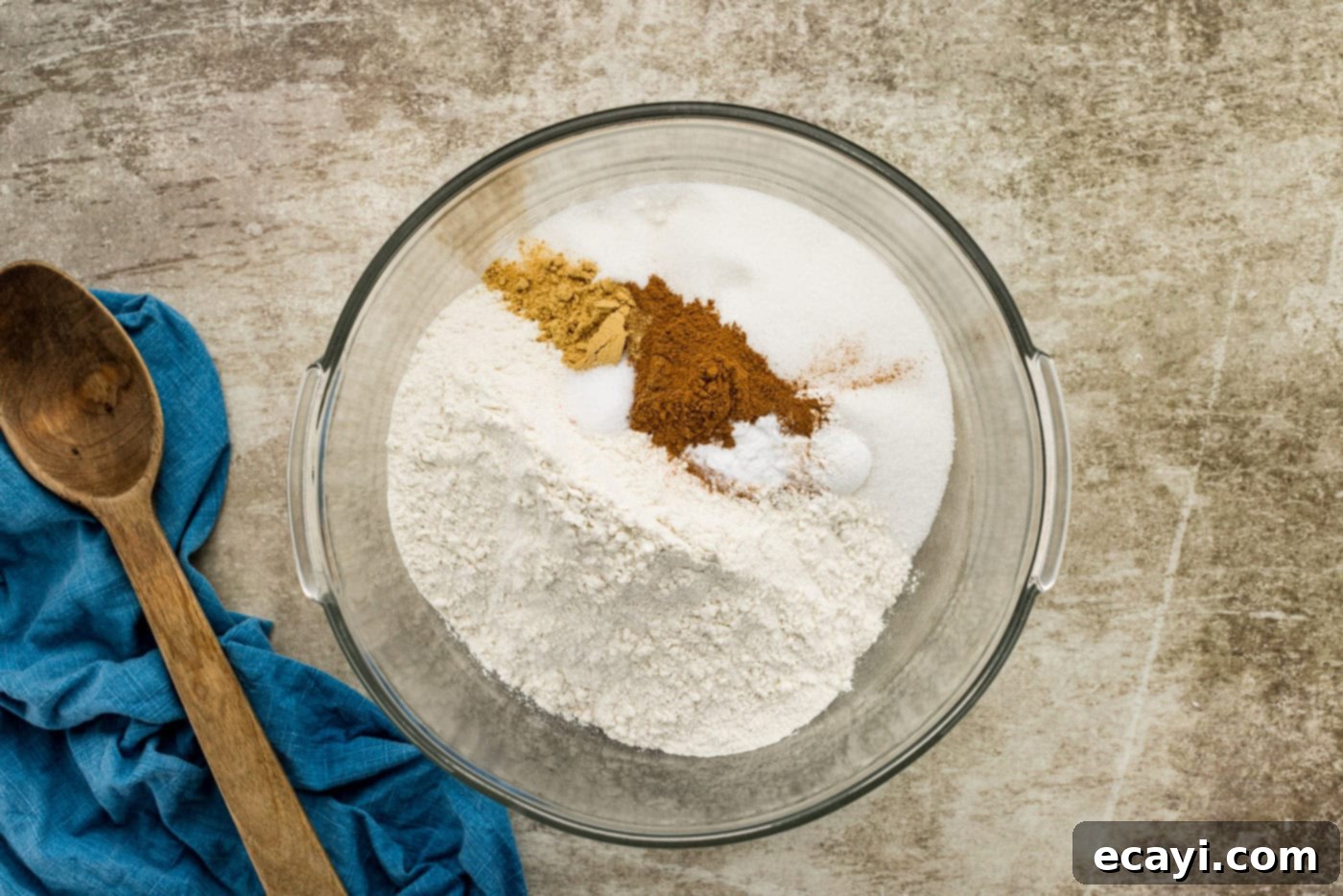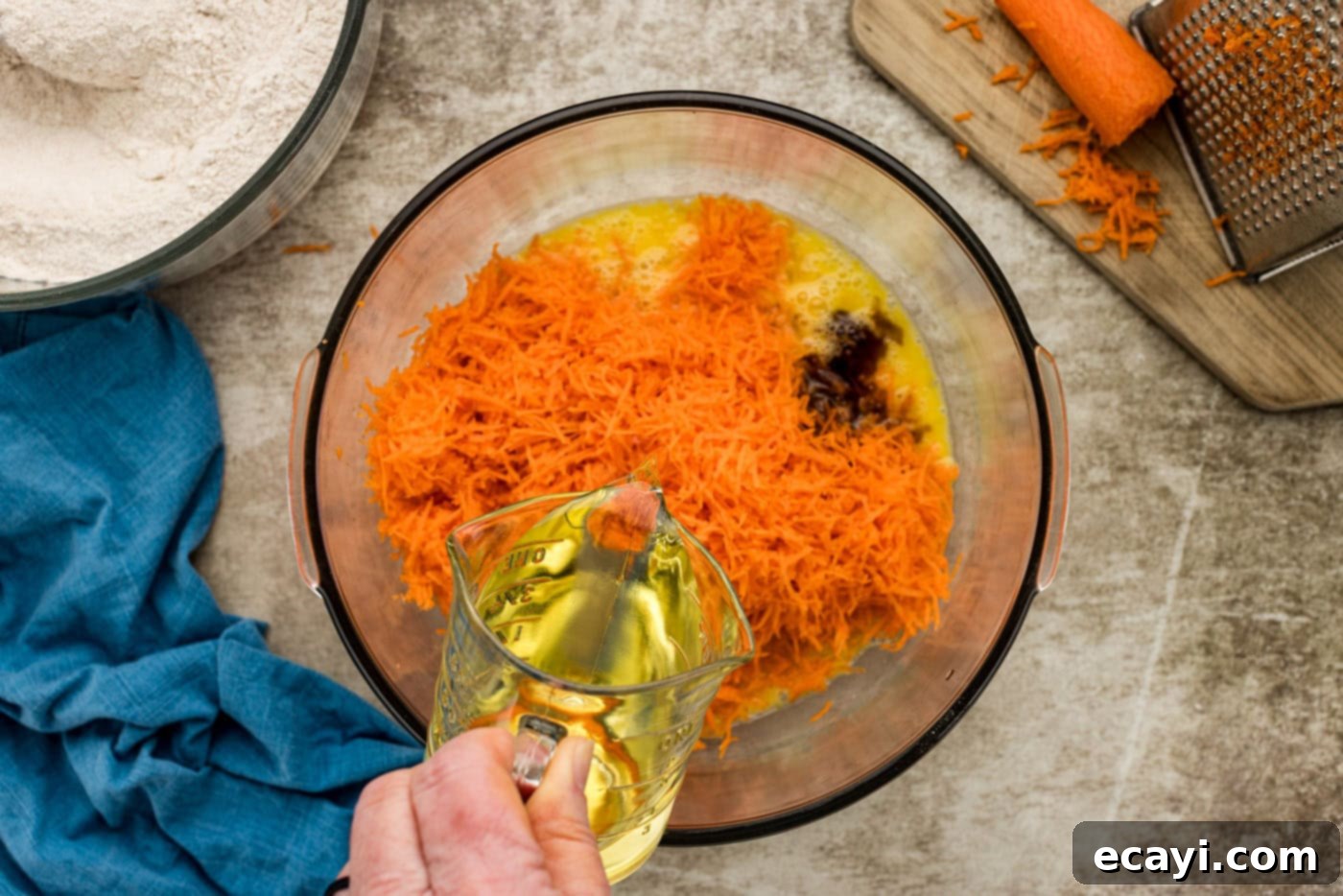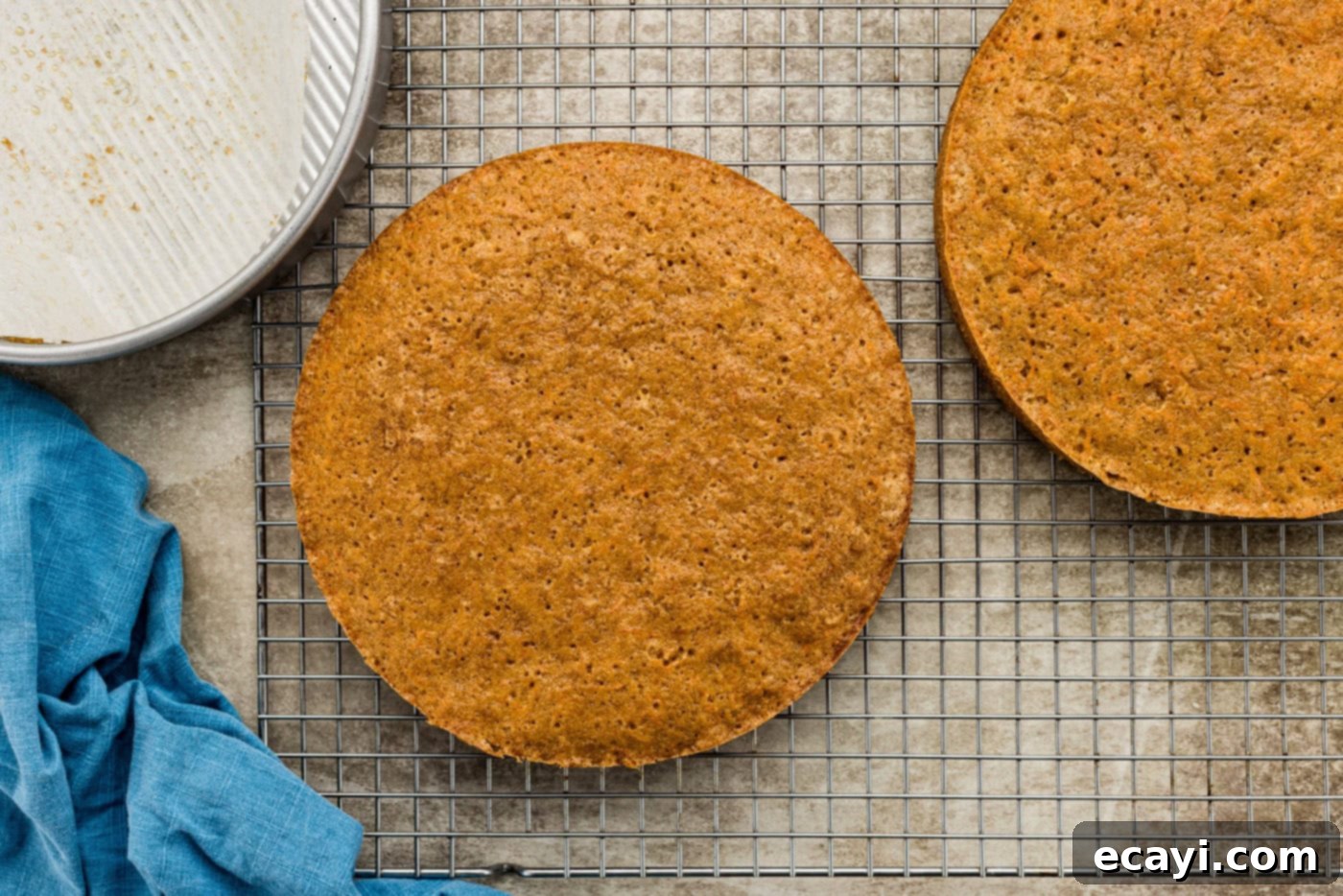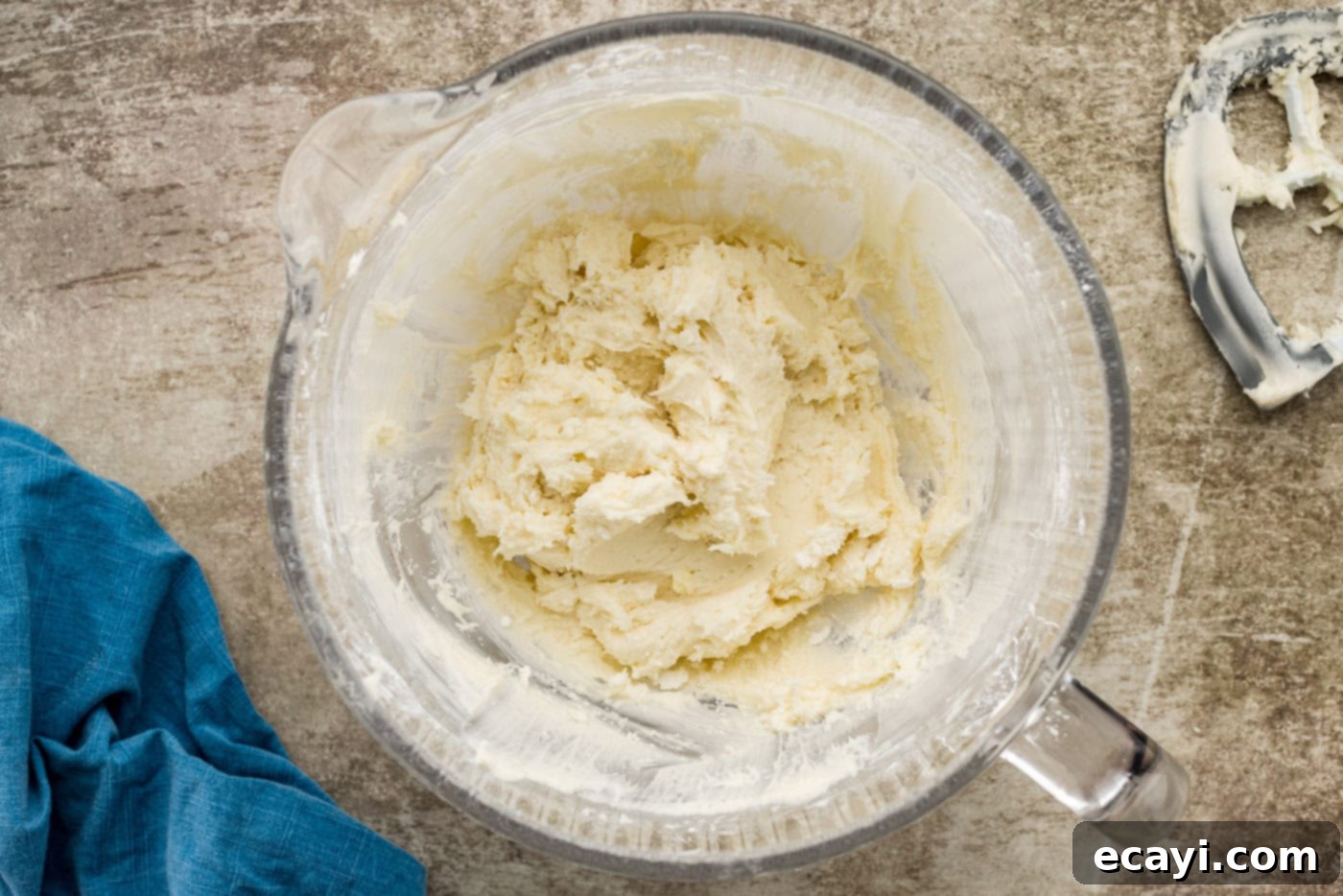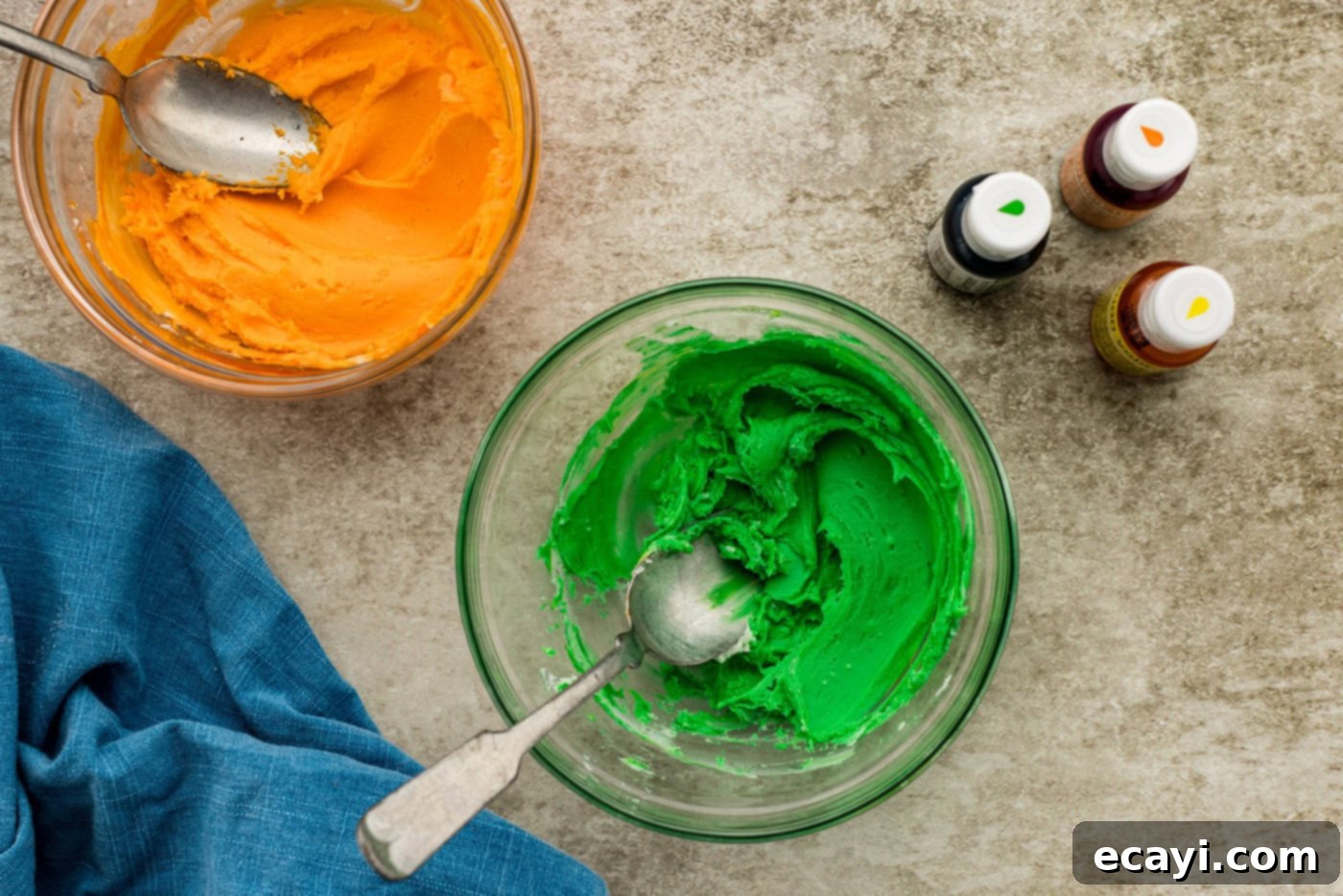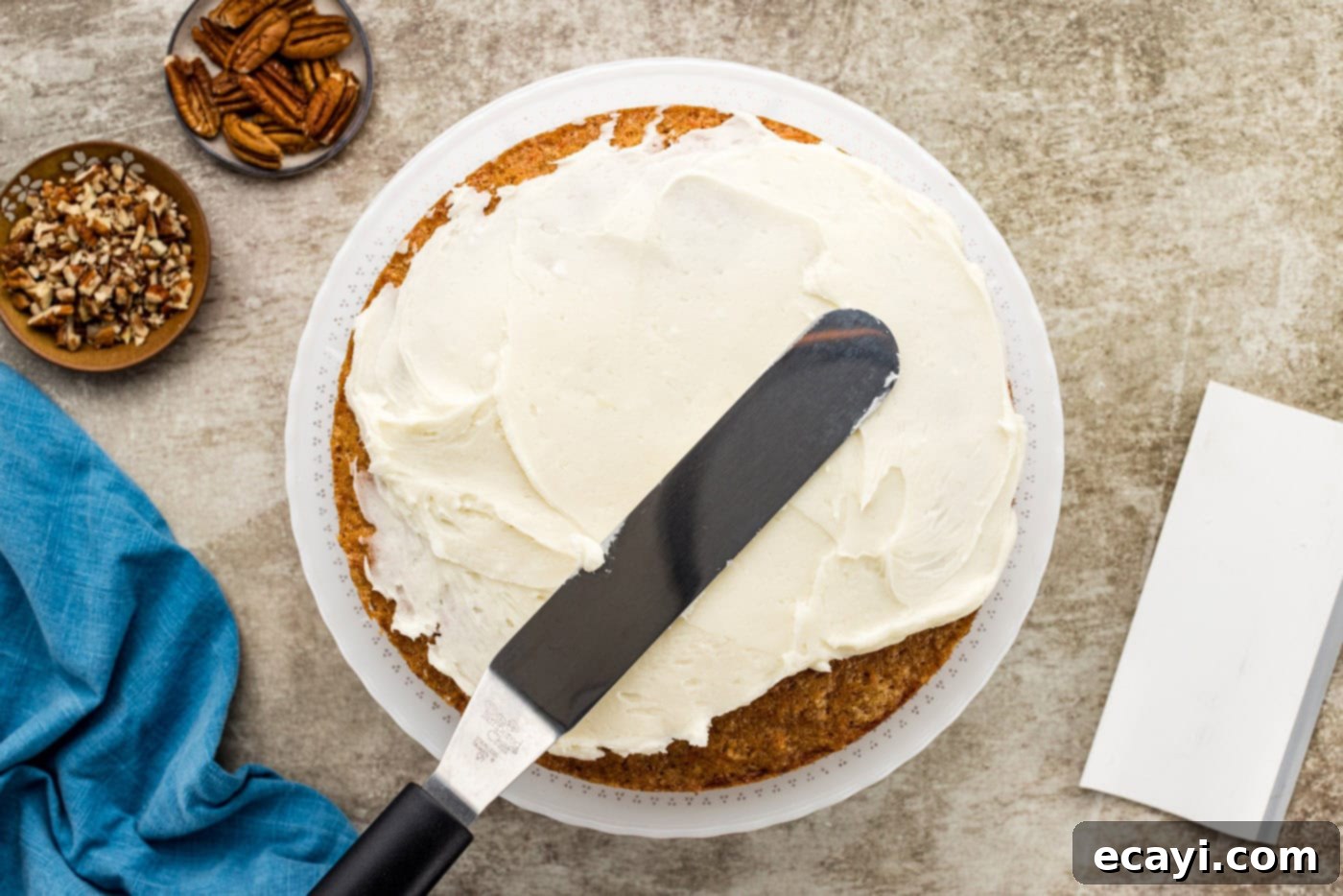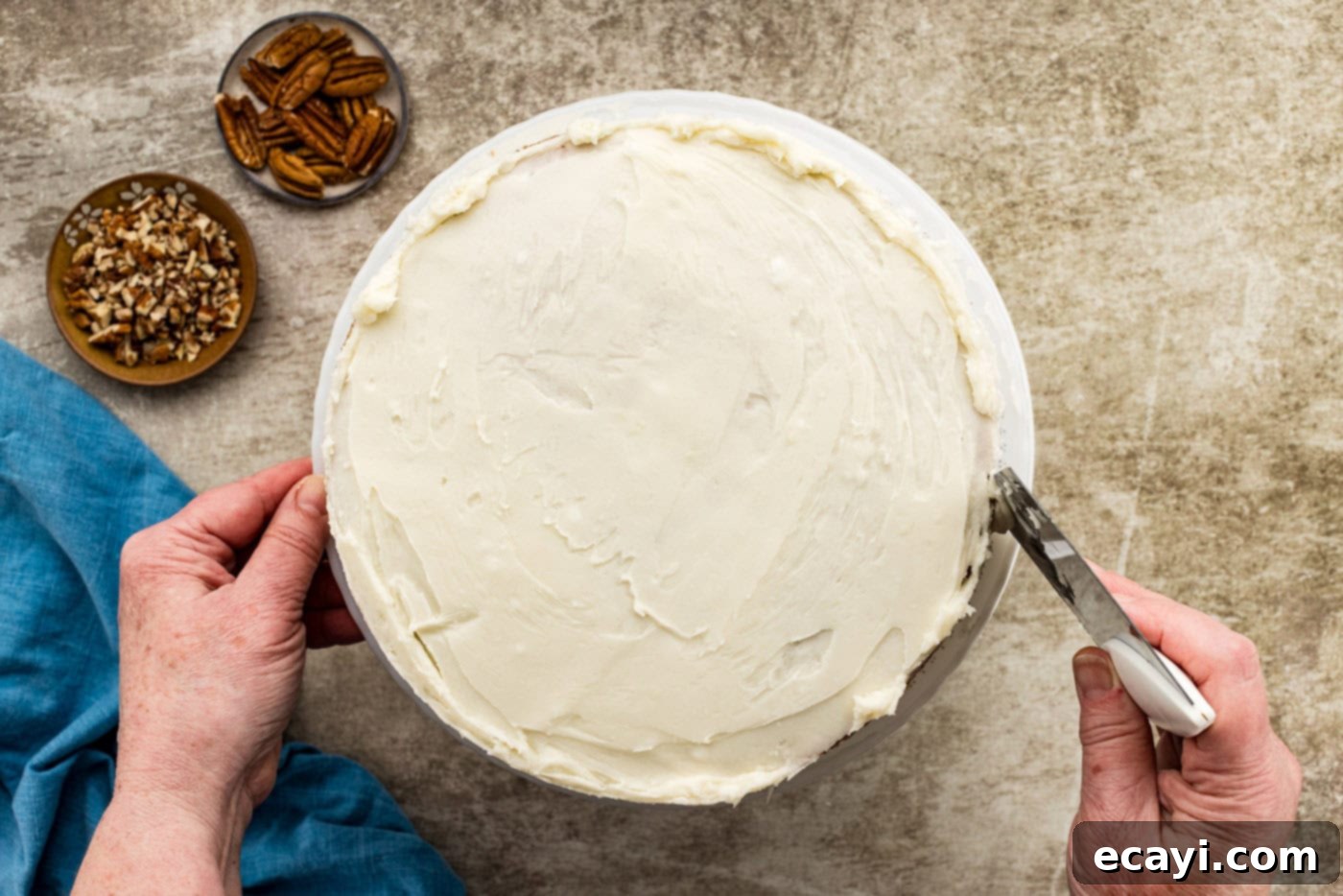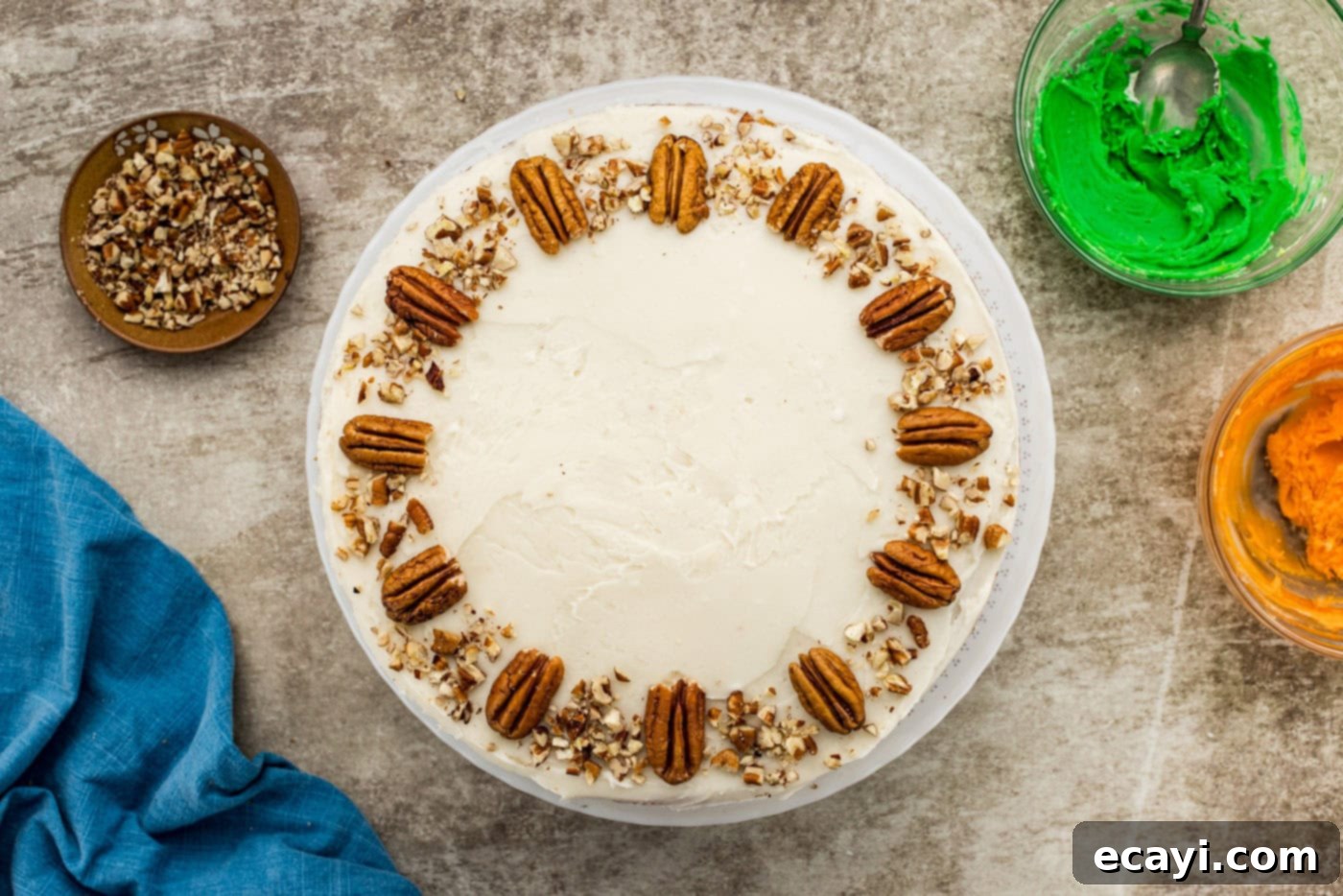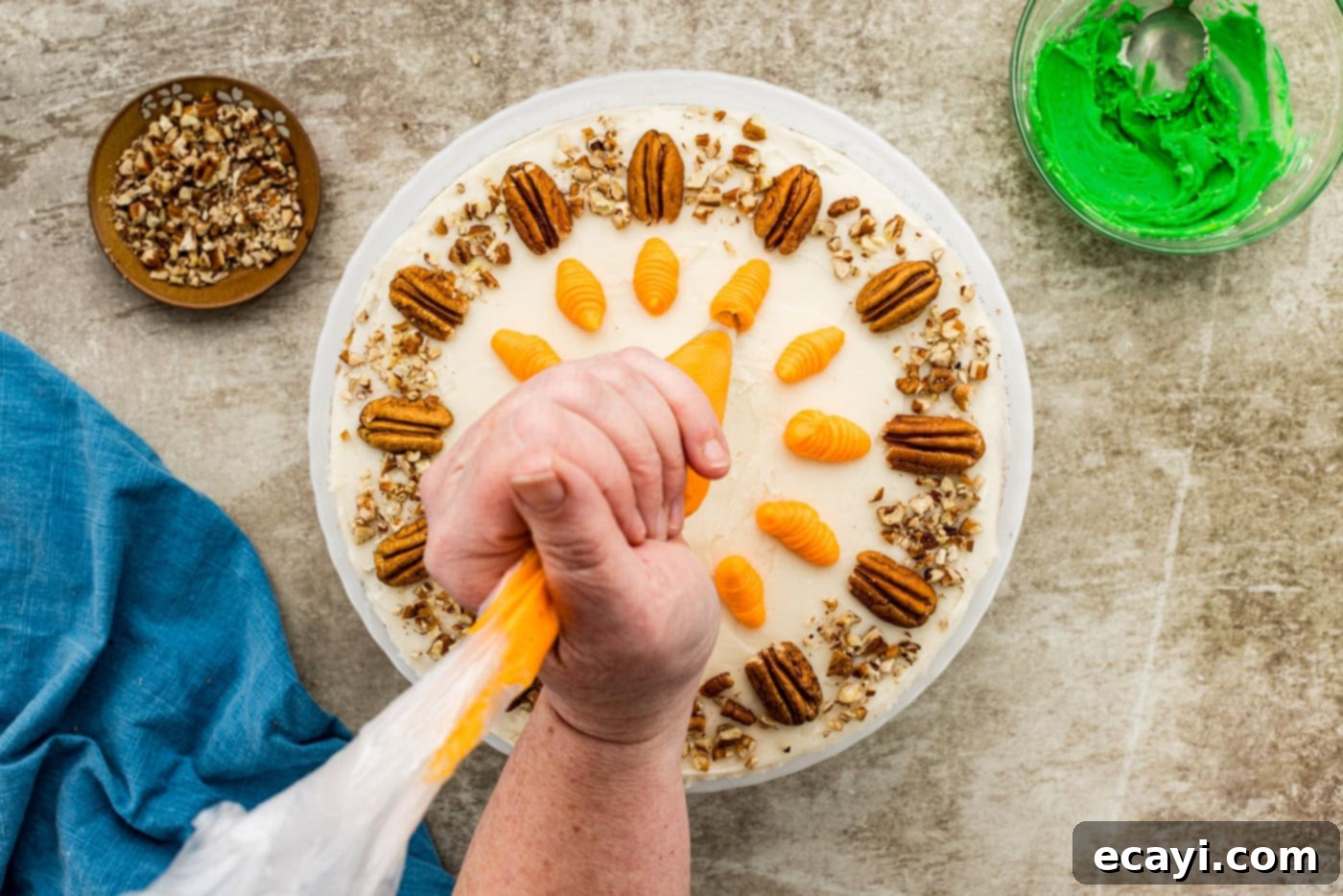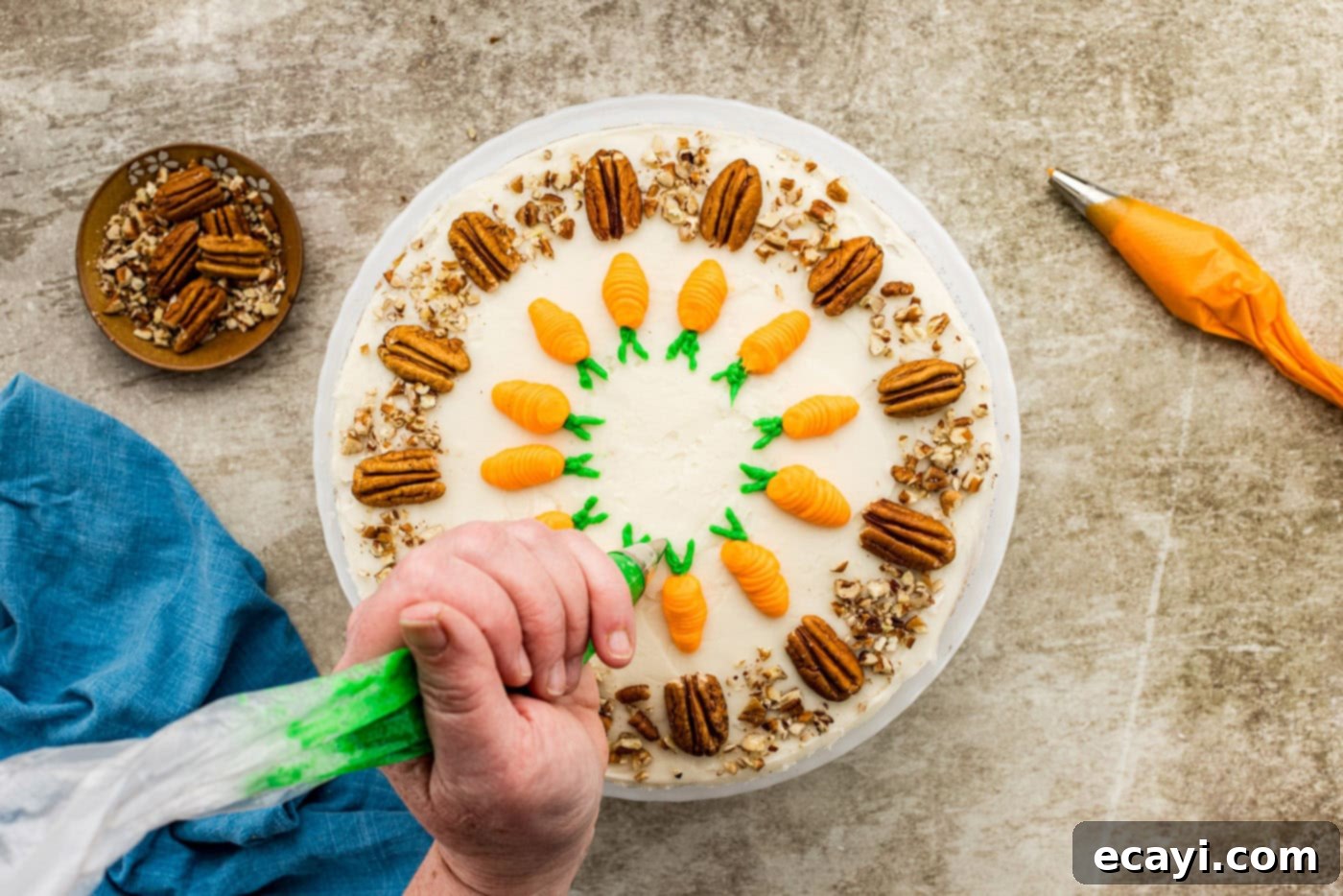The Ultimate Moist & Spiced Carrot Cake Recipe with Silky Cream Cheese Frosting
Prepare to be enchanted by this truly sensational carrot cake. It’s a magnificent two-tiered dessert, generously studded with finely shredded carrots that lend a beautiful texture and natural sweetness. Each tender crumb is warmly spiced with a harmonious blend of cinnamon and a hint of ginger, creating an irresistible aroma that fills your kitchen as it bakes. Finally, this masterpiece is elegantly blanketed with our velvety, rich, and tangy cream cheese frosting – the perfect complement to the moist, flavorful cake layers. This isn’t just a cake; it’s an experience, promising to be the best homemade carrot cake you’ll ever taste!
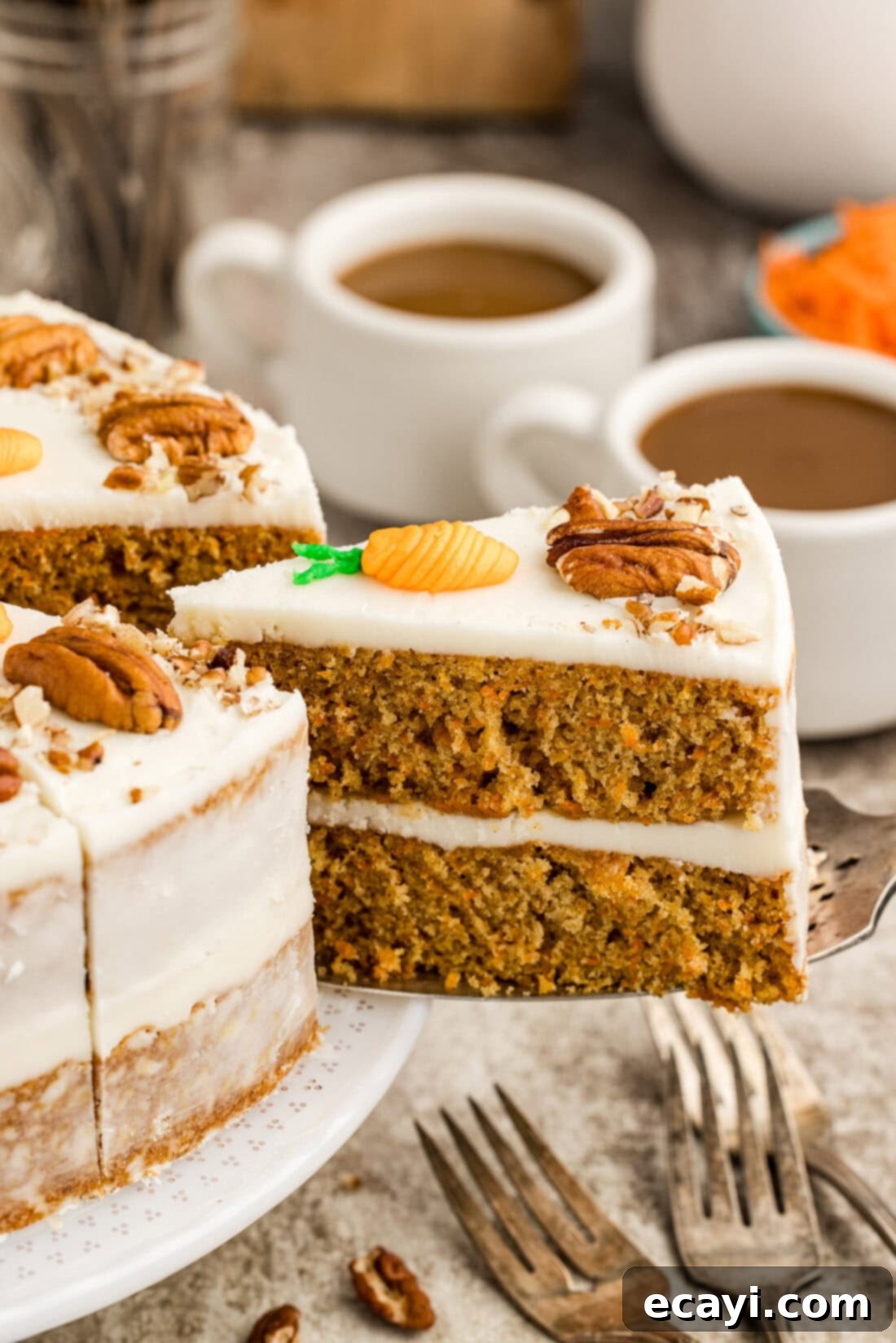
Why This Carrot Cake Recipe Stands Out
We’re thrilled to share what we believe is the absolute best carrot cake recipe, refined over time to deliver consistent perfection. This isn’t just another carrot cake; it’s a labor of love that results in a dessert that’s truly extraordinary. The cake itself boasts a remarkably fluffy, moist, and tender texture, thanks to the careful balance of ingredients and the incorporation of finely shredded carrots. These carrots not only contribute to the cake’s delightful moistness but also give it that beautiful, natural orange hue, making it as pleasing to the eye as it is to the palate. As this spiced carrot cake bakes, the warm notes of cinnamon and optional ginger waft through your home, creating an inviting and comforting aroma that’s simply incredible. But what truly elevates this classic dessert is the silky-smooth, perfectly balanced cream cheese frosting. Layered generously between the cake tiers and artfully crumb-coated on the outside, it provides the essential tangy sweetness that every great carrot cake needs. From the first bite to the last, this homemade carrot cake is an undeniable winner, guaranteed to impress at any gathering or simply as a well-deserved treat for yourself.
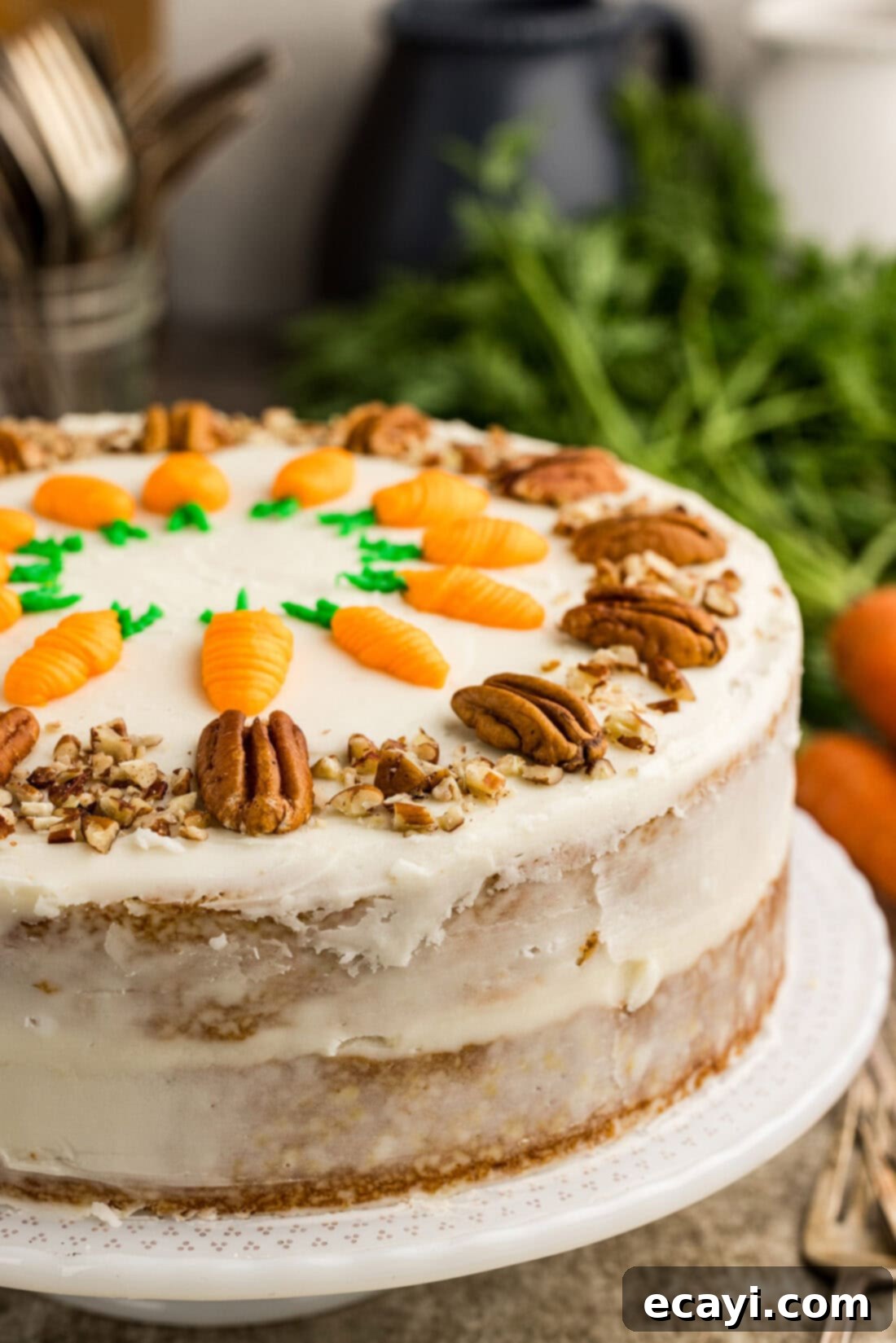
Essential Ingredients for Your Perfect Carrot Cake
To embark on this delightful baking journey, you’ll need a selection of fresh, high-quality ingredients for both the cake layers and the decadent cream cheese frosting. Gather your supplies, and you’ll be well on your way to creating a truly unforgettable dessert. For a complete list of precise measurements and detailed instructions, refer to the printable recipe card conveniently located at the end of this comprehensive guide. We believe that using the best ingredients is the first step towards achieving bakery-quality results right in your own kitchen.
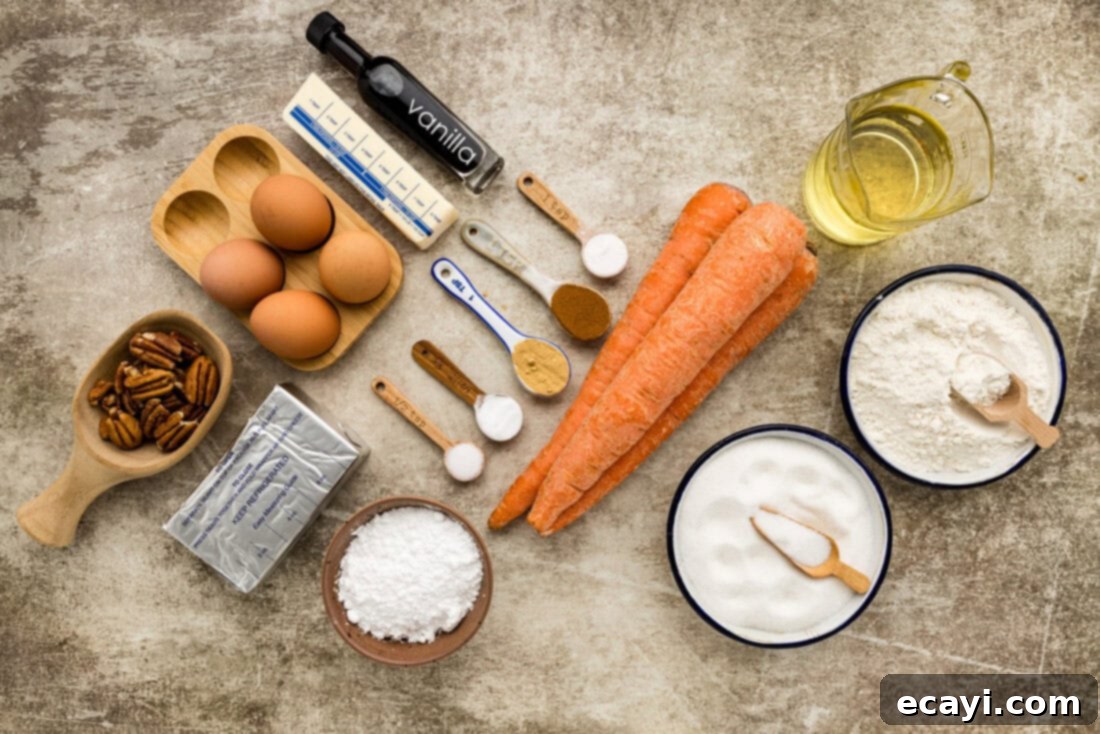
Ingredient Insights & Expert Substitution Tips
Understanding the role of each ingredient is key to baking success. Here’s a deeper dive into what you’ll need and how to achieve the best results for your moist carrot cake:
CARROTS – The star of our show! It is absolutely crucial that your carrots are properly prepared. They must be thoroughly washed, have their ends trimmed, and be completely peeled. Carrot skins can impart a bitter flavor, which is undesirable in a sweet recipe like this classic carrot cake. For the ideal texture within the cake, you’re aiming for a very fine shred. While a food processor might seem quick, it often produces pieces that are too thick or inconsistent, which can lead to a crumbly cake. Therefore, we highly recommend using a traditional box grater for the finest shreds. This ensures the carrots blend seamlessly into the batter, releasing their moisture and sweetness evenly for a perfectly moist cake.
CAKE DRY INGREDIENTS – The leavening agents – baking powder and baking soda – are essential for creating those perfectly risen, light, and fluffy cake layers. Always double-check their freshness before you start baking; stale leavening can result in a dense, flat cake. For consistent, professional-level baking results, weighing your dry ingredients with a kitchen scale is always preferable to using volume measurements (cups). Too much flour, for example, is a common pitfall that can easily lead to an overly dense and dry carrot cake, detracting from its signature moistness.
EGGS – Temperature matters! Using room temperature eggs is a simple but significant step that greatly impacts the final texture of your cake. When beaten, room temperature eggs incorporate and trap air far more efficiently than cold eggs, leading to a lighter, airier, and fluffier cake. Cold eggs, on the other hand, can cause the fats in the batter to seize up, resulting in a denser, sometimes uneven texture. Plan ahead and take your eggs out of the refrigerator at least 30 minutes to an hour before you begin.
OIL vs. BUTTER – This recipe calls for Canola oil, which contributes significantly to the cake’s exceptional moistness. Unlike butter-based cakes, oil-based cakes tend to stay moist for longer and have a softer crumb. Canola oil has a neutral flavor that won’t compete with the warm spices and natural sweetness of the carrots. You can also use other neutral oils like vegetable oil or grapeseed oil as a substitute.
SPICES – Cinnamon is the primary spice, providing that comforting warmth. We specifically recommend Saigon cinnamon for its incredibly fragrant and robust flavor profile, which truly elevates the cake. The addition of ground ginger is optional but highly recommended if you enjoy a more complex, subtly zesty spice blend. Adjust the amounts to your personal preference, but don’t shy away from these aromatic additions!
COMMON ADD-INS (Optional) – While our basic recipe is divine, many enjoy personalizing their carrot cake with additional elements. Consider adding 1 cup of chopped pecans or walnuts for a delightful crunch and nutty flavor. For a burst of sweetness and chewiness, incorporate 1/2 to 1 cup of plump raisins (golden or dark) or dried cranberries. Some bakers also love the tropical tang of crushed pineapple (well-drained) or shredded coconut. If you choose to add these, gently fold them into the batter just before dividing it into pans.
FROSTING – What is a carrot cake without its crowning glory: luscious cream cheese frosting? This tangy, sweet, and smooth frosting is non-negotiable for an authentic experience. When preparing it, be absolutely sure to use confectioners’ sugar (also known as powdered sugar or icing sugar), and never granulated sugar. Granulated sugar will not dissolve properly in the frosting, leaving you with an unpleasantly gritty texture. Sifting your confectioners’ sugar is also a small step that makes a big difference in achieving a perfectly smooth, lump-free frosting.
DECORATION – The beauty of this carrot cake extends beyond its taste. In the detailed recipe card below, we guide you through the process of separating the frosting into three parts, allowing you to elegantly pipe miniature carrots and leaves for a charming, classic presentation. However, feel free to unleash your creativity! You can use all of your frosting for a thicker, smoother coat around the cake if you prefer a more minimalist look. Beyond piped details, we love to add a rustic perimeter of pecan halves and a generous sprinkle of chopped pecans around the top for both visual appeal and an extra nutty bite.
Baking Your Perfect Carrot Cake: A Step-by-Step Guide
These step-by-step photos and detailed instructions are designed to help you visualize each stage of making this incredible carrot cake. For the full printable version of this recipe, complete with precise measurements and comprehensive instructions, simply Jump to Recipe at the bottom of this post.
Creating a moist and flavorful carrot cake is a rewarding experience, and following these steps carefully will ensure a delicious outcome. Attention to detail, from preparing your pans to combining ingredients, makes all the difference.
- **Prepare Your Cake Pans:** Begin by thoroughly spraying two 9-inch round cake pans with Canola cooking spray. For effortless cake release, place two round pieces of parchment paper, cut to fit the bottom of each pan, and spray another layer of cooking spray over the parchment. This essential step ensures your cake layers separate cleanly from the pans after baking, maintaining their perfect shape. Set these prepared pans aside.
- **Preheat Your Oven:** Position the oven rack in the center of your oven. This ensures even heat distribution, crucial for uniform baking. Then, preheat your oven to 350 degrees F (175 degrees C). Allowing your oven to fully preheat is vital for the cake to rise correctly.
- **Combine Dry Ingredients:** In a large mixing bowl, whisk together the all-purpose flour, granulated white sugar, baking powder, ground cinnamon, optional ground ginger, Kosher salt, and baking soda. Sifting these ingredients together can help prevent lumps and ensure they are evenly distributed throughout the batter, leading to a lighter, more consistent cake texture.

- **Combine Wet Ingredients:** In a separate large mixing bowl, combine the beaten room-temperature eggs, finely shredded carrots, pure vanilla extract, and Canola oil. Stir this mixture thoroughly until all components are completely combined. The oil contributes greatly to the cake’s moistness, while the room-temperature eggs ensure optimal emulsification with the other wet ingredients.

- **Integrate Wet and Dry Mixtures:** Gradually add the dry flour mixture to the wet ingredient mixture, incorporating a small amount at a time and stirring gently between each addition until just combined. Be careful not to overmix the batter; overmixing can develop the gluten in the flour, leading to a tough cake. Once combined, divide the batter evenly between your two prepared baking pans.
- **Bake the Cake Layers:** Place the filled cake pans on the center rack of your preheated oven and bake for 30-35 minutes. To test for doneness, insert a clean knife or wooden toothpick into the center of each cake. If it comes out clean, the cakes are ready. Once baked, remove the cake pans from the oven and allow them to cool on wire racks for 10 minutes. This initial cooling period allows the cakes to set. After 10 minutes, carefully invert the cakes to remove them from their pans and peel off the parchment paper. Let the cake layers cool completely on the wire racks. It is absolutely essential that the cakes are entirely cool before you attempt to frost them; otherwise, your cream cheese frosting will melt and slide off.

- **Level Your Cake Layers (Optional but Recommended):** Once the cake layers are completely cooled, inspect them for evenness. If they have domed tops, you can carefully level them with a long, serrated bread knife. This step ensures that your cake layers stack perfectly flat and stable, creating a more professional and visually appealing finished cake. If your layers are already quite flat, this step may not be necessary.
Crafting the Silky Cream Cheese Frosting
No carrot cake is complete without a generous slathering of tangy, sweet cream cheese frosting. This recipe delivers a perfectly balanced frosting that’s both easy to make and incredibly delicious. Remember, the key to a smooth frosting is using room-temperature dairy and sifted confectioners’ sugar.
- **Combine Dairy and Vanilla:** In the bowl of a stand mixer fitted with a paddle attachment (or using a hand mixer in a large mixing bowl), combine the room-temperature cream cheese, unsalted butter, and 1 teaspoon of pure vanilla extract. Beat these ingredients together on medium speed until the mixture is light, fluffy, and completely smooth, with no lumps of cream cheese or butter remaining. This usually takes 2-3 minutes.
- **Add Confectioners’ Sugar:** Gradually mix in the sifted confectioners’ sugar, adding about 1/2 cup at a time. Start on low speed to avoid a sugar cloud, then increase to medium until each addition is fully incorporated and the mixture is smooth and creamy. Continue until all the sugar is added and the frosting reaches your desired consistency – thick enough to hold its shape but spreadable.

- **Prepare for Decoration (Optional):** If you plan to pipe decorative carrots and leaves, reserve specific portions of your frosting. Set aside 1/2 cup of frosting for the carrot decorations and 1/4 cup for the leaves. It’s helpful to place these portions into separate small bowls.
- **Color the Carrot Frosting:** To color the 1/2 cup of frosting designated for carrot decor, add 2 drops of orange food coloring and 1 drop of yellow food coloring. Mix until the color is vibrant and uniform.
- **Color the Leaf Frosting:** For the leaf decorations, add 1 drop of green food coloring and 1 drop of yellow food coloring to the 1/4 cup of reserved frosting. Mix thoroughly to achieve a natural-looking green.

- **Chill (if needed):** Set your frosting aside until you are ready to frost the cake. If there’s a significant time gap before frosting, or if your kitchen is warm, you can refrigerate the frosting. However, remember that cream cheese frosting needs to be at room temperature to be perfectly spreadable. If refrigerated, allow it about 30 minutes to an hour to come back to room temperature before you start frosting. You might need to give it a quick whisk again to restore its creamy texture.
Assembling Your Carrot Cake Masterpiece
Assembling a two-tiered cake might seem daunting, but with a few simple techniques, you’ll achieve a beautiful, stable result. This section guides you through creating a stunning presentation, from the initial layering to the final decorative touches.
- **First Layer & Filling:** Place your first cooled cake layer onto a cake turntable (highly recommended for ease of frosting) or directly onto your desired cake stand. Dollop a generous amount of the main cream cheese frosting onto the top of this layer and spread it evenly, allowing it to slightly hang over the edge. This provides a clean start for the sides.
- **Second Layer & Crumb Coat:** Carefully place the second cake layer directly on top of the frosted first layer. Add another generous amount of frosting to the top of this second layer, spreading it out so it also overhangs the edge. Now, add smaller dollops of frosting around the sides of the entire cake. Using a bench scraper, cake comb, and/or an offset spatula, begin to spread the frosting thinly and evenly around the sides and top of the cake. This initial thin layer is known as a “crumb coat” – it traps any loose crumbs, ensuring your final frosting layer is smooth and clean.

- **Achieving the “Naked” or Crumb Coat Look:** To replicate the popular “naked cake” or light crumb coat aesthetic seen in our photos, a cake turntable is incredibly helpful. While gently rotating the cake on the turntable, hold a bench scraper vertically against the sides of the cake, applying light, even pressure. This action removes excess frosting, revealing hints of the cake layers beneath. Scrape the excess frosting into a clean bowl. Repeat this process a couple of times, adjusting pressure as needed, until you achieve your desired level of “nakedness” – where the cake is visible but still protected by a thin, smooth layer of frosting.

Decorating Your Carrot Cake
The final touches bring your carrot cake to life! These steps focus on the charming pecan perimeter and piped carrot design, but remember to let your creativity guide you.
- **Pecan Perimeter & Chopped Pecans:** Carefully place twelve pecan halves around the top perimeter of your cake, spacing them evenly. These pecans serve as excellent markers for where you will pipe your decorative carrots. Once the halves are in place, generously sprinkle additional chopped pecans over the entire top surface of the cake for added texture and nutty flavor.

- **Piping the Carrots:** Transfer your orange-colored frosting into a piping bag fitted with a Wilton tip 10 or a similar round piping tip. Using the pecan halves as a guide, begin piping your carrots. Start with gentle pressure at the ‘tip’ of the carrot (closest to the cake’s edge), then gradually apply more pressure as you elongate the carrot towards the center of the cake. This technique creates a natural, ridged appearance and a wider, thicker end for your piped carrots. The “thick end” of each piped carrot should be closer to the centermost part of the cake.

- **Adding the Leaves:** Now, switch to your green-colored frosting in a piping bag fitted with a smaller tip, such as a Wilton tip 5. For each piped carrot, simply pipe two short, parallel lines from the thickest end, extending slightly upwards. These lines will beautifully represent the carrot leaves, adding a vibrant finishing touch to your homemade carrot cake.

Frequently Asked Questions & Expert Baking Tips
Here are some common questions and essential tips to ensure your carrot cake turns out perfectly every time:
We’ve rigorously tested this carrot cake recipe both with and without cake strips, and we’re happy to report that the cake layers come out beautifully either way. Because carrot cake typically has a slightly denser texture, similar to a quick bread, it doesn’t always require cake strips to bake evenly and often rises fairly flat on its own. If you’re accustomed to using cake strips for other cake recipes and prefer to do so, by all means, use them! However, don’t worry if you don’t have them on hand; your carrot cake will still be fantastic.
Absolutely! Carrot cake is a fantastic make-ahead dessert, as the flavors often deepen and meld beautifully overnight. You can prepare, frost, and decorate your entire carrot cake 1-2 days in advance of when you plan to serve it. For optimal freshness and to prevent it from drying out, we highly recommend storing it in an airtight cake carrier in the refrigerator. This method will keep your cake moist and delicious.
Yes, carrot cake freezes exceptionally well! You have a couple of options: you can freeze the unfrosted cake layers or individual frosted slices. To freeze the cake layers before assembly, ensure they are completely cooled. Wrap each layer tightly in plastic wrap several times, followed by a layer of aluminum foil. For best results, freeze them flat (you can place them on a baking sheet until firmly frozen, then remove the baking sheet). To freeze individual frosted slices, first flash freeze the slices on a baking sheet until they are solid to the touch. Once frozen, wrap each slice individually in plastic wrap, then in a layer of aluminum foil. Transfer the wrapped slices to a freezer-safe plastic zip-top bag. To thaw, simply remove the wrapping from the cake layers or slices and allow them to thaw slowly in the refrigerator overnight. This method ensures you can enjoy a perfect slice of carrot cake whenever a craving strikes!
For the absolute best texture in your carrot cake, we strongly recommend using a box grater to finely shred your carrots. While a food processor is faster, it often produces thicker, less consistent pieces that can make your cake crumbly or disrupt its smooth texture. Fine shreds blend seamlessly into the batter, ensuring even moisture and flavor distribution.
If your cream cheese frosting is too runny, it’s often due to warm butter or cream cheese, or not enough confectioners’ sugar. Try adding more sifted confectioners’ sugar, about 1/4 cup at a time, mixing well after each addition. If it’s still too soft, refrigerate the frosting for 15-30 minutes, then re-whip it. If it’s too stiff, add a tiny bit of milk or cream (1 teaspoon at a time) and mix until it reaches the desired consistency.
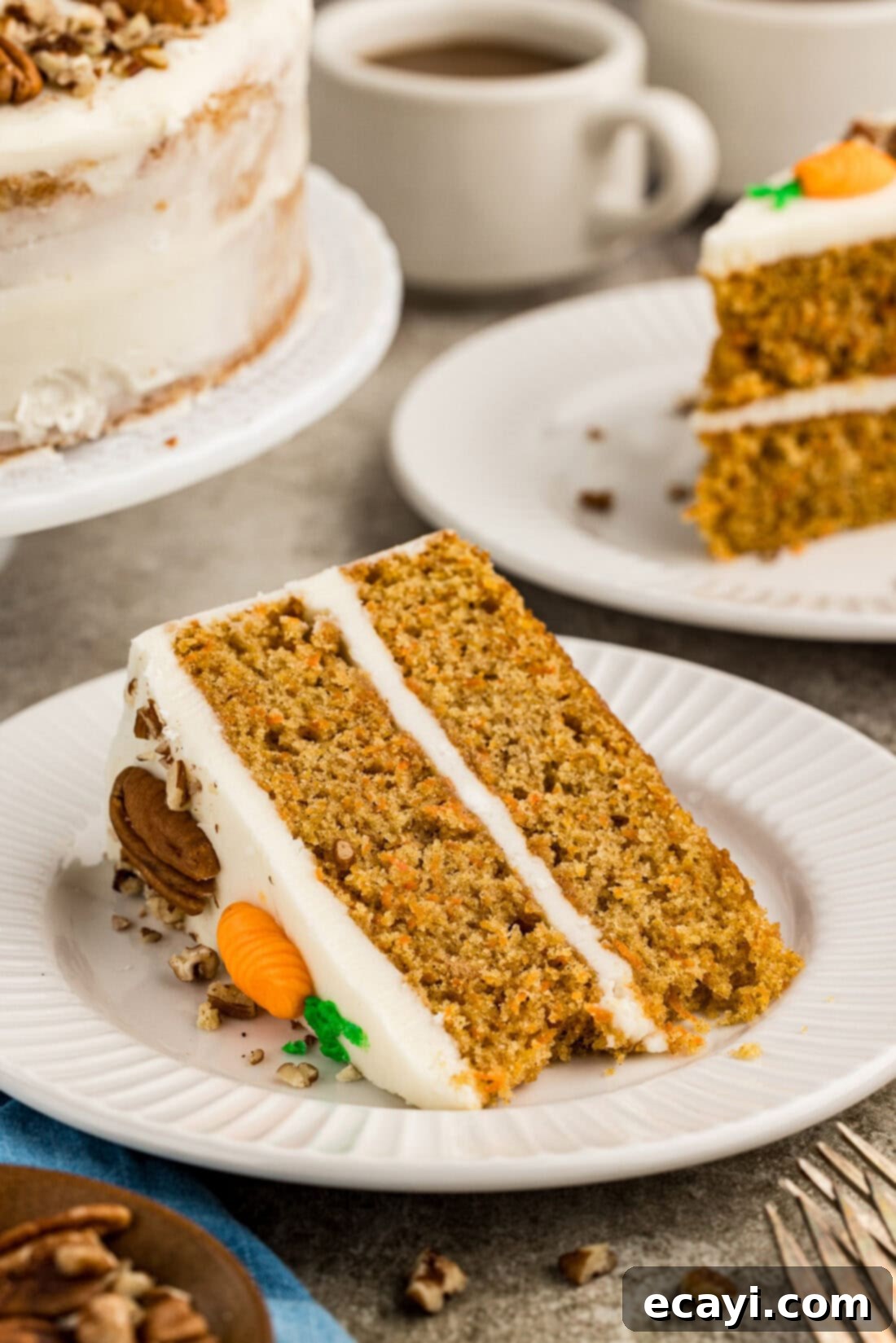
Serving Suggestions for Your Delightful Carrot Cake
For many, including myself, a perfectly baked carrot cake with its rich cream cheese frosting is an absolute kryptonite – a sweet indulgence that’s impossible to resist! I’ll unashamedly admit to enjoying a slice for breakfast with my morning coffee more times than I can count. This exquisite cake, with its warm spices and comforting flavors, is a beloved staple around Easter and springtime celebrations, but its appeal certainly isn’t limited to a specific season. It makes a truly lovely and impressive dessert for a wide array of occasions, from special birthdays and elegant bridal showers to heartwarming baby showers and casual potlucks of all magnitudes. Its universal charm and crowd-pleasing taste ensure it’s always a welcome addition to any dessert table. Feel free to garnish your carrot cake however you prefer, and enjoy it whenever the moment feels right – whether that’s as a late-night treat, an unconventional breakfast, or a classic dessert. The decision is entirely yours, and you can’t go wrong!
Explore More Carrot Cake Delights
If you’ve fallen in love with the flavors of this classic carrot cake, you’ll be delighted to know that its versatility extends to many other forms. Here are more creative and delicious carrot cake-inspired recipes to try:
- Carrot Cake Roll
- Carrot Cake Trifle
- Carrot Cake Truffles
- Carrot Cake Sandwich Cookies
I genuinely love to bake and cook, and my greatest joy is sharing my kitchen experiences and delicious recipes with all of you! Remembering to come back each day for new inspiration can sometimes be a challenge, which is why I offer a convenient newsletter every time a new recipe posts. Simply subscribe today and start receiving your free daily recipes directly in your inbox!
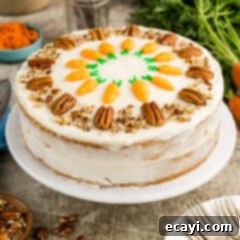
Classic Moist Carrot Cake
IMPORTANT – Don’t forget to scroll up and read the comprehensive Frequently Asked Questions and Expert Tips section within the blog post for valuable insights that will help you perfect your cake!
Print It
Rate It
Save ItSaved!
Ingredients
To make the Carrot Cake Layers
- Canola cooking spray for greasing the 2 cake pans
- 2 cups all-purpose flour 275g. or the same amount of cake flour
- 2 cups granulated white sugar 437g
- 2 teaspoons baking powder
- 2 teaspoons ground cinnamon *Saigon cinnamon is most fragrant
- 1 teaspoon ground ginger optional
- ½ teaspoon Kosher salt
- ½ teaspoon baking soda
- 4 large eggs beaten *room temperature
- 3 cups shredded carrots 285g. very finely shredded, lightly packed. *the carrots must be peeled and ends cut
- 1 teaspoon pure vanilla extract
- ¾ cup Canola oil
Cream Cheese Frosting
- 8 ounces cream cheese plain, room temperature
- ½ cup unsalted butter 1 stick, room temperature
- 1 teaspoon pure vanilla extract
- 5-6 cups confectioner’s sugar sifted. 744g (weighed pre-sifted)
Optional Toppings
- 12 pecan halves
- ¼ cup chopped pecans
Optional Piped Carrots
- orange food coloring
- yellow food coloring
- green food coloring
Things You’ll Need
-
2 9-inch cake pans
-
Stand mixer or hand mixer
-
Wire cooling racks
-
cake turntable optional for decorating
-
Bench scraper
-
Wilton tip 5 optional for decorating
-
Wilton tip 10 optional for decorating
Before You Begin
- The carrots must be washed, ends cut, and completely peeled. Carrot skins are bitter and since this is a sweet recipe, it’s best to do so. You’re aiming for a fine shred, so I recommend using a box grater as opposed to a food processor. Otherwise, too thick of carrots can cause the cake to be crumbly.
- Double check your baking powder and baking soda for freshness.
- Use room temperature eggs which when beaten, trap air more efficiently leading to a lighter, fluffier cake.
Instructions
-
Spray the 2 (9 inch) round cake pans with Canola cooking spray. Place 2 round pieces of parchment paper fitted to the bottom of the cake pans and spray more cooking spray over the parchment. This helps the cake separate from the cake pan after baking completely intact. Set the prepared pans aside.Canola cooking spray
-
Make sure the oven rack is in the center of the oven then preheat your oven for 350 degree F.
-
In a large mixing bowl, stir the flour, granulated white sugar, baking powder, ground cinnamon, ground ginger (optional), Kosher salt, and baking soda.2 cups all-purpose flour, 2 cups granulated white sugar, 2 teaspoons baking powder, 2 teaspoons ground cinnamon, 1 teaspoon ground ginger, 1/2 teaspoon Kosher salt, 1/2 teaspoon baking soda
-
In another large mixing bowl, add the beaten eggs, 3 cups finely shredded carrot, 1 teaspoon vanilla extract, and 3/4 cup Canola oil. Stir the mixture until completely combined.4 large eggs, 3 cups shredded carrots, 1 teaspoon pure vanilla extract, 3/4 cup Canola oil
-
Gradually add the flour mixture to the wet mixture, stirring in between each addition, until combined. Add an even amount of batter to each prepared baking pan.
-
Bake the cake layers in the center rack for 30-35 minutes. Test for doneness by inserting a knife or wooden toothpick into the center of the cake and it should come out clean. Cool the cake pans on wire racks for 10 minutes, then remove the cake layers from the cake pans and allow to cool completely on the wire racks. Remove and discard the parchment paper. The cake must be completely cooled before applying the frosting.
-
When the cake is completely cool, if the cake needs to be leveled you can now level with a bread knife. This allows you to stack the layers evenly when assembling. If the layers are pretty flat, it is not necessary to level the cake layers.
To Make the Cream Cheese Frosting
-
In a stand mixer (or using a hand held electric mixer), in a large mixing bowl, mix the cream cheese, unsalted butter, and pure vanilla extract until combined.8 ounces cream cheese, 1/2 cup unsalted butter, 1 teaspoon pure vanilla extract
-
Gradually mix in the sifted confectioner’s sugar, sprinkling 1/2 cup at a time until the mixture is smooth.5-6 cups confectioner’s sugar
-
Reserve 1/2 cup of frosting to pipe on the carrots, and 1/4 cup to pipe the leaves (if desired). You can place them all in separate bowls.
-
To color the 1/2 cup of frosting for the carrot decor, add 2 drops of orange food coloring and 1 drop yellow.
-
To color the 1/4 cup of frosting for the leaves, add 1 drop green and 1 drop yellow.
-
Set your frosting aside until ready to frost the cake. If you have some time until frosting the cake, you can refrigerate it but make sure it is room temperature before frosting. It usually takes a 1/2 hour to become room temperature after removing from the refrigerator.
To Assemble the Carrot Cake
-
Add the first layer to the cake turntable or cake stand. Add frosting to the top of the layer and spread it out so that it hangs over the edge. Add the 2nd layer. Add enough frosting so that it hangs over the edge. Add dollops of frosting to the sides and using a bench scraper, cake comb and/or offset spatula spread the frosting on the sides.
-
To create a crumb coat look as seen in our photos, it’s easiest to use a turntable. Using a bench scraper, gently rotate around the cake removing excess frosting. Scrape excess frosting into a bowl. Repeat a couple times until you achieve the desired level of “nakedness” on your cake.
To Decorate
-
Place twelve pecan halves around the perimeter of the cake. The pecans are a good indicator as to where you should pipe the carrots on. Sprinkle with additional chopped pecans.12 pecan halves, 1/4 cup chopped pecans
-
Using a Wilton tip 10 or similar, begin piping the carrots. You can use the pecan halves as a marker for where to pipe each carrot. Start with gentle pressure then apply more pressure as you elongate the carrot. Doing so will create ridges and enlarge the carrot as seen in the photos. The “thick end” of the carrot should be in the centermost part of the cake.
-
Using a Wilton tip 5 for the leaves, simply pipe two lines from the thick end of your carrots.
Expert Tips & FAQs
- You can prepare, frost, and decorate your carrot cake 1-2 days in advance. I would highly recommend storing it in a cake carrier in the refrigerator so that it stays air-tight.
- Freezing – You can freeze the carrot cake layers before assembling. Wrap the fully cooled cake layers in plastic wrap a few times followed by a layer of aluminum foil. Freeze them flat (optionally on a baking sheet until firmly frozen).
- To freeze individual frosted slices of this cake, flash freeze the slices on a baking sheet. Once solid to the touch, wrap them individually in plastic wrap followed by a layer of aluminum foil. Transfer the wrapped slices to a plastic zip-top bag. To thaw, remove the wrapping and allow to thaw in the refrigerator.
Nutrition
The recipes on this blog are tested with a conventional gas oven and gas stovetop. It’s important to note that some ovens, especially as they age, can cook and bake inconsistently. Using an inexpensive oven thermometer can assure you that your oven is truly heating to the proper temperature. If you use a toaster oven or countertop oven, please keep in mind that they may not distribute heat the same as a conventional full sized oven and you may need to adjust your cooking/baking times. In the case of recipes made with a pressure cooker, air fryer, slow cooker, or other appliance, a link to the appliances we use is listed within each respective recipe. For baking recipes where measurements are given by weight, please note that results may not be the same if cups are used instead, and we can’t guarantee success with that method.
This recipe for the ultimate moist carrot cake originally appeared here on April 6, 2019, and has since been extensively updated with new photos, expanded expert tips, and enhanced details to provide even more value. The recipe is inspired by “Carrot Cake” from The Better Homes and Gardens New Cook Book and was initially contributed to the blog by Sara from Life’s Little Sweets. We continue to refine and share the best version of this classic dessert!
